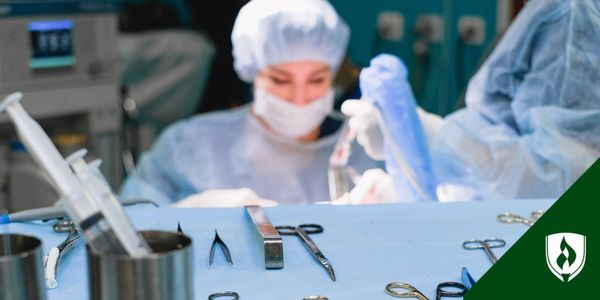What Is the Difference Between a Surgical Technologist and a Surgical Assistant?
10/07/2025

If you’re exploring careers in the healthcare field, you might be asking what is the difference between surgical technologist and surgical assistant? While both roles are part of the surgical team, they differ in their job duties, educational paths, and level of responsibility in the operating room. Understanding the distinction between surgical technologists and surgical assistants can help you decide which path fits your skills and interests.
Surgical Assistant vs. Surgical Technologist
When comparing surgical assistant vs surgical technologist, the main difference is in their direct involvement during surgery. Surgical assistants play a hands-on role1 with more advanced responsibilities, while surgical technologists focus1 on preparation, support, and maintaining a sterile environment.
A surgical assistant’s typical responsibilities may include:1
- Retracting tissues
- Controlling bleeding
- Assisting surgeons with surgical techniques
- Closing surgical sites and suturing minor wounds
Surgical technologists, sometimes called surgical techs, surgical technicians, or operating room technicians, are primarily responsible1 for preparation and support.
Their job duties may include:1
- Sterilizing surgical instruments and surgical equipment
- Maintaining a sterile environment and sterile field
- Passing the correct surgical tools to the surgeon
- Helping the healthcare team keep procedures efficient and safe
Both surgical technologists and surgical assistants work closely with surgeons and other members of the healthcare team, though surgical assistants may carry more advanced2 responsibilities that require additional education and training.
Roles of Surgical Technologists and Assistants in the Operating Room
The operating room is a dynamic, fast-paced environment where every member of the surgical team has a crucial role.
Technologists and surgical assistants must:1
- Apply sterilization techniques to ensure patient safety
- Ensure surgical instruments and surgical tools are organized and ready
- Communicate clearly with surgeons, registered nurses, and other healthcare professionals
- Adapt to the demands of surgical procedures in real time
If they’re assisting surgeons directly or preparing the operating room, both roles are essential in supporting safe and efficient surgical care.
Educational Path for Surgical Technologists
The educational path to become a surgical technologist is structured2 to help students build foundational knowledge of surgical technology along with practical experience in the operating room. Programs are often designed to prepare students for certification and to work alongside healthcare professionals in surgical settings.
Most surgical technologists3 earn an associate degree in surgical technology, which includes:
- Coursework in human anatomy and physiology, medical terminology, and surgical technology
- Hands-on training in operating room procedures within different Surgical Tech Practicum courses
- Practice with sterilization techniques and surgical equipment
- Clinical experiences to apply skills in real-world settings
Upon graduation, students may be eligible to take the CST National Surgical Technologist Certification exam. Students are eligible to prepare and take the National Center for Competency Testing (NCCT) Tech in Surgery – Certified TS-C exam.
At Rasmussen University, the surgical technology program is accredited by CAAHEP and designed to:
- Prepare students for the CST exam
- Combine online coursework with in-person training
- Include multiple clinical rotations in healthcare organizations
- Be completed in as few as 21 months
Rasmussen does not offer a surgical assistant program, but its accredited surgical technology program is designed to help prepare students for entry-level surgical technologist roles.
Educational Path for Surgical Assistants
Many surgical assistants complete2 certification or degree programs to prepare for the role. Others may choose to work as surgical technologists and receive additional on-the-job training to become first assistants.
Surgical Assistant and Surgical Technologist Job Growth
According to the Bureau of Labor Statistics (BLS) Occupational Outlook Handbook, both roles are projected4 to see job growth of 6% from 2023 to 2033.
This demand is influenced by an increase in surgical procedures, an aging population, and the ongoing need for trained healthcare professionals in hospitals and outpatient care centers.
Comparing Job Duties of Surgical Technologists and Assistants
Understanding the daily responsibilities of each role can help you decide which career path best aligns with your strengths and interests.
Surgical technologists may work1 to:
- Prepare the operating room and surgical equipment
- Sterilize surgical tools and supplies
- Hand the correct surgical tools to the surgeon during procedures
Surgical assistants’ typical responsibilities may include:1
- Retracting tissues during surgery
- Controlling bleeding and managing minor wounds
- Assisting surgeons in closing surgical sites
Both technologists and surgical assistants must collaborate with other members of the healthcare team to ensure the operating room runs safely and efficiently.
Work Settings and Career Development
Surgical technologists and surgical assistants are employed in a range of healthcare organizations.
According to the BLS, the most common settings for surgical assistants include:5
- Hospitals (42%)
- Dentist offices (25%)
- Physician offices (14%)
- Self-employed workers (10%)
- Outpatient care centers (5%)
According to the BLS, the most common settings for surgical technologists include:5
- Hospitals (69%)
- Physician offices (11%)
- Outpatient care centers (11%)
- Administrative and support services (3%)
- Dentist offices (2%)
As they gain experience, surgical technologists may pursue2 additional education to become a surgical assistant. Others transition into teaching, leadership, or specialized surgical teams. Some surgical assistants may have opportunities to pursue specialized2 fields or supervisory roles, depending on employer needs and experience.
Choosing Between a Surgical Technologist or Assistant Career
When deciding between surgical assistant vs surgical technologist, it’s important to consider the role you want to play in the operating room.
Surgical technologist (surgical tech / surgical technician):1
- May focus on preparing and maintaining the sterile field and supporting the surgical team
- May provide an entry point into the healthcare field with hands-on training and certification options
Surgical assistant (first assistants):1
- May involve direct participation in surgical techniques and assisting surgeons
- May include a deeper understanding of anatomy, procedures, and advanced responsibilities
Both surgical technologists and surgical assistants are essential members of the surgical team. While their duties differ, each role contributes to safe and effective surgical procedures. Rasmussen University offers3 a CAAHEP-accredited surgical technology program to prepare students with the knowledge and skills needed to enter the medical field as surgical technologists.
1Bureau of Labor Statistics, U.S. Department of Labor, Occupational Outlook Handbook, Surgical Technologists: What They Do, available at https://www.bls.gov/ooh/healthcare/surgical-technologists.htm#tab-2 (visited Aug. 18, 2025). Employment conditions in your area may vary.
2Bureau of Labor Statistics, U.S. Department of Labor, Occupational Outlook Handbook, Surgical Technologists: Work Environment, available at https://www.bls.gov/ooh/healthcare/surgical-technologists.htm#tab-4 (visited Aug. 18, 2025). Employment conditions in your area may vary.
3Rasmussen University, Surgical Technologist Associate’s Degree Program, available at https://www.rasmussen.edu/degrees/health-sciences/surgical-technologist/associates/ (visited Aug. 18, 2025).
4Bureau of Labor Statistics, U.S. Department of Labor, Occupational Outlook Handbook, Surgical Technologists: Job Outlook, available at https://www.bls.gov/ooh/healthcare/surgical-technologists.htm#tab-6 (visited Aug. 18, 2025). Employment conditions in your area may vary.
5Bureau of Labor Statistics, U.S. Department of Labor, Occupational Outlook Handbook, Surgical Technologists: How to Become One, available at https://www.bls.gov/ooh/healthcare/surgical-technologists.htm#tab-3 (visited Aug. 18, 2025). Employment conditions in your area may vary.



